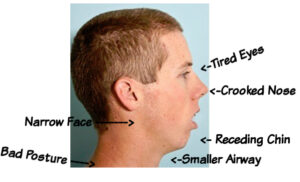Mouth Breathing and Your Health
 A Question and Answer Guide
A Question and Answer Guide
For people who struggle with mouth breathing, it isn’t easy to “just shut your mouth”. Habits can be difficult to change! The muscles in the cheeks, lips and and tongue have learned to function in an incorrect way and the body does not know how to breath normally through the nose.
In order to stop mouth breathing the muscles must be re-trained to function in new ways.
An Orofacial Myofunctional Therapist (OMT) can be instrumental in helping you to learn how to breathe in a healthy way. OMT’s are skilled at helping children and adults gain control over muscle patterning habits, including those involved in mouth breathing.
A consultation with an OMT can be very valuable. If the muscles are not retrained, problems with general health, speech, orthodontic treatment, dental health, swallowing and breathing may persist throughout life. Myofunctional Therapy is needed to make the muscular changes associated with mouth breathing.
 This child is at an ideal age to start Myofunctional therapy. He is still growing and will see a dramatic improvement to his facial features and structures.
This child is at an ideal age to start Myofunctional therapy. He is still growing and will see a dramatic improvement to his facial features and structures.
Mouth Breathing
It is perfectly natural to breathe through your mouth at certain times, such as when exercising or exerting yourself. Breathing through the mouth most of the time however, can cause health problems. These problems can be especially detrimental for children because it can effect the development of the face as the child grows. Most of us bring air into our body through our nose. The nose is designed to act as a natural humidifier and filtering system for the air we breathe. When we can’t get enough air through our nose however, our mouth takes over. Breathing through the mouth most of the time was not natures intent. When this happens, problems can occur.
 Why Would Someone Mouth Breathe?
Why Would Someone Mouth Breathe?
Mouth Breathing is a posture habit that can develop for numerous reasons. Below are some
of the most common.
- Allergies
- Thumb or finger sucking habit
- Enlarged tonsils or adenoids
- Chronic nasal congestion
Each of these five factors make it physically impossible for a person to nasal breathe. If nasal breathing is not possible, the bodies only choice is to mouth breathe. Mouth breathing changes the way the tongue works: It develops a “tongue thrust.” A tongue thrust affects speech, swallowing, breathing and chewing in problematic ways. The position of the tongue can effect orthodontic treatment and chance of relapse is higher once braces are removed.
Facial Growth and Development
Breathing through your mouth can actually change the shape of your face and alter your appearance. This is especially true for children because they are still growing. Mouth breathing can cause long narrow faces and mouths, less defined cheekbones, small lower jaws and weak chins. It can also cause “gummy” smiles and crooked teeth.
Other Effects on the Body
Using the mouth for breathing disrupts our natural body mechanics. It can effect a number of bodily functions and lead to symptoms such as:
- Headaches
- Gingivitis and gum disease
- Sore throat and cold symptoms
- Bad breath and higher risk for cavities
- Poor sleep – leading to chronic fatigue
- Digestive disturbances -Reflux, gas, etc..
The root of the problem in many cases is actually an oxygen issue. The nose produces nitric oxide which improves your lungs ability to absorb oxygen. Nitric oxide increases the ability to transport oxygen throughout your body, including inside your heart. It relaxes vascular smooth muscle and allows blood vessels to dilate. Nitric Oxide is also anti fungal, antiviral, anti parasitic and anti bacterial. It helps the immune system to fight infections. Lower Oxygen levels can lead to poor sleeping habits. In children this can adversely affect growth and academic performance. It has been connected to ADD and ADHD symptoms.
In adults, poor oxygen concentration in the bloodstream has been associated with high blood pressure, heart problems, sleep apnea and other medical issues. Mouth breathing causes posture changes where the head rests in a foreword position and the shoulders slump.


